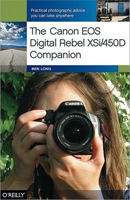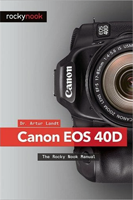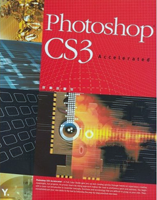The Canon EOS Digital Rebel XSi/450D Companion
by Ben Long
O’Reilly Press
ISBN: 978-0-596-52086-1, 271 pages
$24.99 US, $24.99 CN
Canon EOS 40D: The Rocky Nook Manual
by Artur Landt
Rocky Nook
ISBN: 978-1-933952-33-8
$29.95 US, $29.95 CN
Photoshop CS3 Accelerated
by Blues Kim
YoungJin
ISBN: 978-8931434378
$24.99 US, $24.99 CN, £14.99 UK
It’s difficult for a mere book reviewer like myself to understand how publishers and book writers can keep up with the frequent updates in digital software and hardware. Just when you purchase a Canon camera or the latest update of Photoshop, new versions of these products come out in less than a year’s time. It seems like writers and publishers have to scramble to keep up with the ever expanding technology. But somehow they get the job done, and in most cases very well.
If you’re a Canon shooter, you no doubt have heard or followed the recent update to its EOS line of cameras. As a reviewer, I wish I could say I’ve gotten my hands on their newest cameras, if nothing else but for review purposes. But sadly I haven’t. However, I was sent a couple of new books on Canon cameras for review that provide me some insight about the new Canon Digital Rebel XSi/450D and the Canon 40D. I have the predecessors to both of these cameras, so what is discussed in these books under review are not foreign to me.

Canon EOS 40D: The Rocky Nook Manual
Iwould imagine that it’s difficult for an author to know the type of audience that will typically read his or her book about a Canon camera. Will it mainly be novice photographers purchasing and learning digital photography for the first time or it will mostly be experienced photographers purchasing an upgrade? Dr. Artur Landt’s book on the Canon 40D seems to address the latter audience. I found parts of the book very technical, meaning that it might not be as accessible to novice Canon users or digital photographers. He starts off the book talking about camera technology of the camera, with illustrations of the image sensor, the optical low-pass filter, the DIGIC III Image Processor, and Demosaicing, and the like. While a professional or advance user of a Canon EOS camera might find this information useful, it will probably be a turn off for novice users. The first chapter might have been more accessible outlining some of the specific differences between the Canon 40D and its, or at least just highlighting the newest features and how they will benefit photographers.
Almost every page of Landt’s book, however, does include grey boxed tips and tricks that will be useful to novice digital photographers. He also has useful and important chapters on autofocus and exposure, exposure modes, flash photography, interchangeable lenses, camera accessories, and image output —e.g. transferring camera files to your computer, and processing and printing them using the Canon software provided with the camera.
This instructional text of the manual is supported with Landt’s own well done photography, which rangers from scenic travel photo and portraits, to sports and macro images, which help illustrate the information. But for the most part, the instructional aspects of Landt’s manual are more descriptive, which means he describes the features of and technology behind the Canon 40D, but the manual is short on how-tos. For example, when Landt describes the AF Points used for selective focus in the camera, he doesn’t describe or illustrate how to use the AF Points features. He explains it but doesn’t do a very good showing how. In most technical manuals of this type, you’d expect to see numerous step-by-step outlines for using features of the camera, but that’s not so in this book. And for some odd reason, the book doesn’t come with an index, which is useful for quickly referencing specific information.
So for the most part, this Rocky Nook Manual may be most useful for intermediate and advance Canon EOS photographers, but not for those who just purchased the Canon camera for the first time. I would strongly advise previewing the book in hand before purchasing it.

The Canon EOS Digital Rebel XSi/450D Companion
Ben Long’s book on the Canon XSi/450D is the type of instructional manual that will appeal to both novice and intermediate photographers. Long is a prolific writer who has written entire companion books on digital photography, Aperture 2.0 (Apple’s pro image management and processing application), digital filmmaking, and the ins and out of the camera Raw format. He maintains a popular website, www.completeditalphotographery.com that features a wide array of articles and resources.
Long’s book takes readers from setting up the Rebel XSi/450D for simple automatic shooting, providing tips on how to hold the camera, framing a shot, dealing with back lighting, and playing back shots. Of course, he also outlines the body parts and all the features of the camera. Every page is illustrated and outlined with step-to-step instructions for using all the features of the Canon’s entry level EOS camera. Long provides practical examples based on a typical photographer’s workflow. Later chapters go into more detail about advance shooting modes, and particularly how to control the light coming into the camera. His writing is very accessible and is not weighted down with technical jargon, though important technical aspects of the camera are explained.
Long’s companion book is the type I would recommend to students in my digital photography workshops because it reveals camera features often overlooked by most novice photographers. Chapter 5 for his book, “Photography 101,” is good introduction to how light and exposure work to produce effectively exposed images. The ending chapters get more into the art of photographers, focusing more on composition, using various focal lengths, shooting panoramas, and handling low light situations.
This companion book is a fine introduction to digital photography and those purchasing the Canon Rebel for the first time. It might also be a good refresher guide for intermediate photographers as well.

Photoshop CS3 Accelerated
If you’re a serious digital photographer, you’re no doubt doing some post-processing of photos. And if you’re even more serious, you probably no doubt use some version of Photoshop CS or Photoshop Elements in your post-production workflow. Well, in terms of Blues Kim’s Photoshop CS3 Accelerated, accelerated really refers novice or general users of Photoshop. This book is not for intermediate or advance users who use the program for more professional purposes.
This 8×10 book is well laid out with space for underlining and jotting notes. Every page is illustrated with step-by-step instructions. The first few pages show how to install the program and then move on to explaining the various basic tools of CS3. Chapters include how-tos and exercises on making selections in images, retouching photos, working with layers, using paths, types, and shapes; understanding channels, making color corrections, and using various Photoshop filters. The book includes a CD containing all the Photoshop source files for the book’s exercises.
But depending on type of photography you do, this book may or not be helpful. If you’re nature photographer, portrait, or wedding photographer, for example, I would say this book is not for you. It’s far too general. If you’re a hobbyist or say a scrapbooker looking to learn more about the program, you may find this book useful.
The source files used in the exercises are not very interesting, but that might help new users to Photoshop feel less challenged about using the program. As a rather experienced Photoshop user and one who has taught and written about the program, I would have started off the early chapters of the book explaining the use of layers, since layers are the heart of Photoshop and are often the most difficult to understand for new users.
The exercises in the book could be more real world exercises, illustrating the type of projects that most users will actually do with their photographs or layout designs. Instead, the book makes heavy use of stock images rather than the type of images typical photographers take and make. The photo for example used to explain blend modes simply does not do justice for illustrating the power of this Photoshop feature. Using the Soft Light or Overlay blend mode can easily add significant contrast and color punch to photos, but you would not know that from the photo used in this book.
Also while the book does point to advance features of Photoshop CS3 like layer paths, channels, layer comps, there’s no exercises about using the powerful smart object feature of CS3, and not a single page as for as I can see about how to use Photoshop actions which is an essential time saving tool that every avid Photoshop user should know and use.
I also think the included CD could have included video tutorials showing some of more difficult Photoshop techniques and features, such as curves adjustments. These type of video tutorials are not difficult to make, and it would provide a more multimedia learning experience for many users.
I don’t want underrate this book too much, because I know that Photoshop CS3 or even earlier versions of the program can be very daunting for would-be users. So any book is helpful. But I just happen to think there are better books on CS3 already published. Thus, this is another book that I strongly suggest previewing in-hand before purchase. It will probably not appeal to more serious photographers or Photoshop users.
email – MyMac Magazine – Twitter – Advertise – Reviews Archive – Podcast

Leave a Reply
You must be logged in to post a comment.